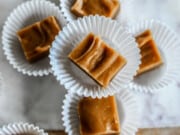Ah, the peanut. Like many of us, the peanut walks around all day long having most people think we’re one thing when we are in fact something quite different. For decades the peanut has been going through an identity crisis, and is only recently getting the recognition and credit it deserves for being such a tasty and nutritious member of the plant kingdom. And the butter that results from roasting and grinding them is truly one of life’s great pleasures (especially when eaten with a spoon directly out of the jar at about 3am). So what journey has the peanut taken to get here? How nutritious is it? And is it a good option for gluten-free dieters?
The peanut’s identity crisis starts with the fact that it is not a nut at all, but is in fact a legume and is more closely related to beans than nuts. Unlike nuts, they grow below ground and are also sometimes called earthnuts or ground nuts. Up until the 1930’s, peanuts were thought so lowly of that they were used mostly for animal feed. One man in particular, George Washington Carver, was mostly responsible for bringing peanuts to the American mainstream as he developed many delicious recipes using the peanut. Carver was to the peanut as Einstein was to quantum physics and Freud was to psychology. Without Carver, the delicious and nutritious concoction known as peanut butter may never have (gasp!) existed.
So how nutritious is peanut butter? Its delectability has never really been in question, but its nutritional value has always been somewhat controversial. There was a time, before we knew the horrific health consequences of trans fats, that peanut butter was widely regarded as being a healthy food choice. At the time, brands like Jif, Peter Pan, and Skippy ruled the market and their versions of peanut butter were loaded with trans fats to make them more shelf-stable and “no stir.” But now that all-natural peanut butters are back in vogue, its nutritional status is at an all-time high. Just always make sure you buy all-natural peanut butter that is free of trans fat. That layer of fat at the top is a good thing, and requires just one good stir and a trip to the refrigerator to become the perfect consistency. If the peanut butter you’re buying contains anything except peanuts and salt, it is time to try another brand.
Peanut butter is naturally gluten-free, but can be processed on shared equipment so always read labels and, as always, be wary of cross-contamination. But especially for the gluten-free dieter, peanut butter is an absolute nutritional superstar. All those B vitamins like folate, riboflavin, and niacin that are sometimes lacking in gluten-free diets? Peanut butter is rife with them. Another nutrient often lacking in gluten-free diets is fiber, and peanut butter has ample amounts of that too. In addition, peanut butter contains significant amounts of many other healthy nutrients like unsaturated fatty acids and vitamin E. It also contains antioxidant levels that rival many fruits and vegetables and is a good source of protein as well. Peanut butter even contains resveratrol, the compound also found in red wine and dark chocolate that may confer positive health benefits with respect to cancer, the cardiovascular system, and blood sugar control.
So we’ve seen that the peanut has come a long way. Once thought of as barely suitable for human consumption and often mistaken for a real nut, the peanut is finally really getting to shine its nutritional star brightly and be recognized for the extremely healthy legume that it is. When turned into spreadable butter, it is even easier to digest and is loaded with nutritional benefits that make it a healthy choice for anyone. But especially because the nutrients it’s rich in are often those that are lacking in a gluten-free diet, peanut butter is an especially healthy choice for those living gluten-free. So don’t feel too much guilt about that next middle-of-the-night peanut butter binge.
Article Courtesy: Andrew Steingrube







Let Us Know What You Think